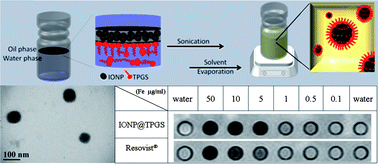Polyethylene glycol-based biocompatible and highly stable superparamagnetic iron oxide nanoclusters for magnetic resonance imaging†
Abstract
We developed a simple emulsion and

* Corresponding authors
a
Department of Chemistry and Center of Nanoscience and Nanotechnology, National Chung Hsing University, Taichung 402, Taiwan
E-mail:
pslai@email.nchu.edu.tw
b Department of Medical Imaging, Buddhist Tzu Chi General Hospital, Taipei Branch, New Taipei City 231, Taiwan
c Biophotonics and Molecular Imaging Research Center, National Yang-Ming University, Taipei 112, Taiwan
d Institute of Biomedical Engineering, National Taiwan University, Taipei 100, Taiwan
We developed a simple emulsion and

 Please wait while we load your content...
Something went wrong. Try again?
Please wait while we load your content...
Something went wrong. Try again?
S. Lai, J. Hsiao, H. Yu, C. Lu, C. Huang, M. Shieh and P. Lai, J. Mater. Chem., 2012, 22, 15160 DOI: 10.1039/C2JM32086J
To request permission to reproduce material from this article, please go to the Copyright Clearance Center request page.
If you are an author contributing to an RSC publication, you do not need to request permission provided correct acknowledgement is given.
If you are the author of this article, you do not need to request permission to reproduce figures and diagrams provided correct acknowledgement is given. If you want to reproduce the whole article in a third-party publication (excluding your thesis/dissertation for which permission is not required) please go to the Copyright Clearance Center request page.
Read more about how to correctly acknowledge RSC content.
 Fetching data from CrossRef.
Fetching data from CrossRef.
This may take some time to load.
Loading related content
